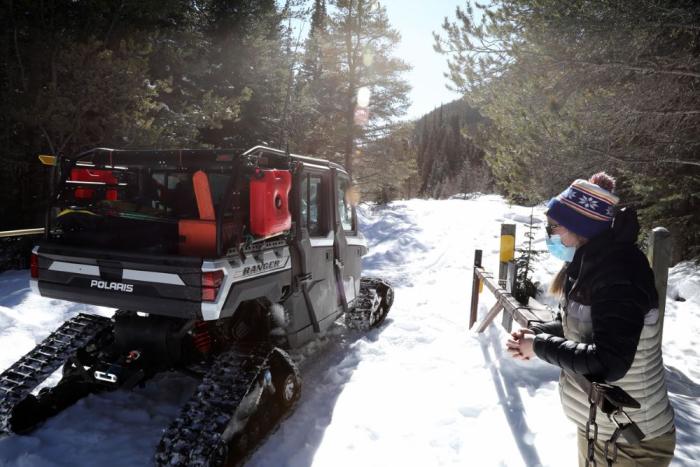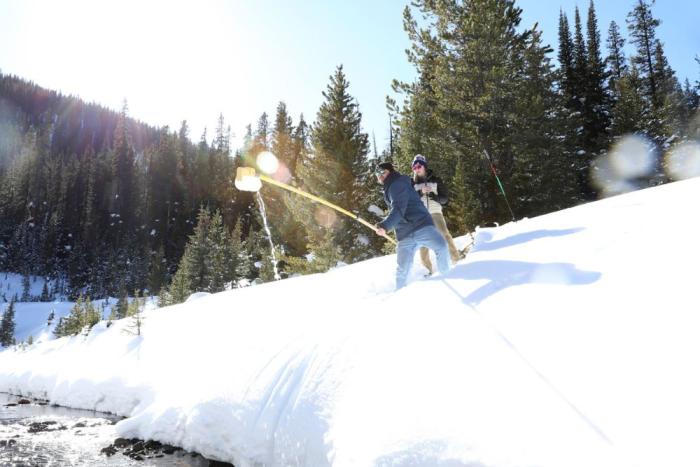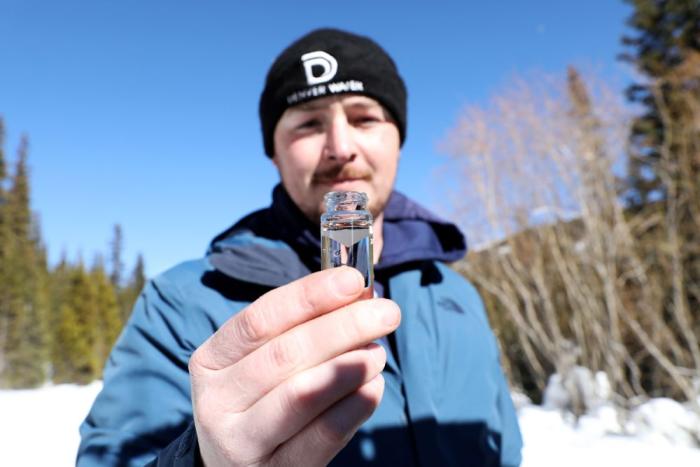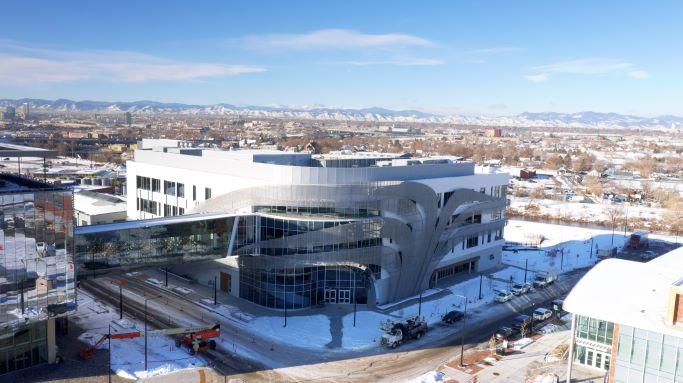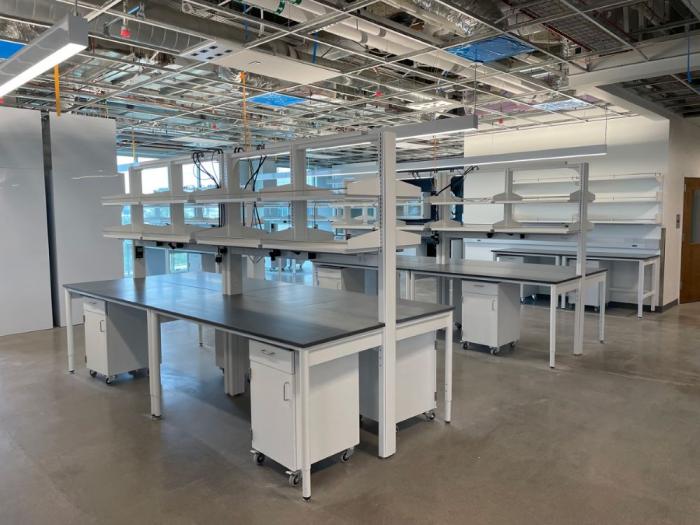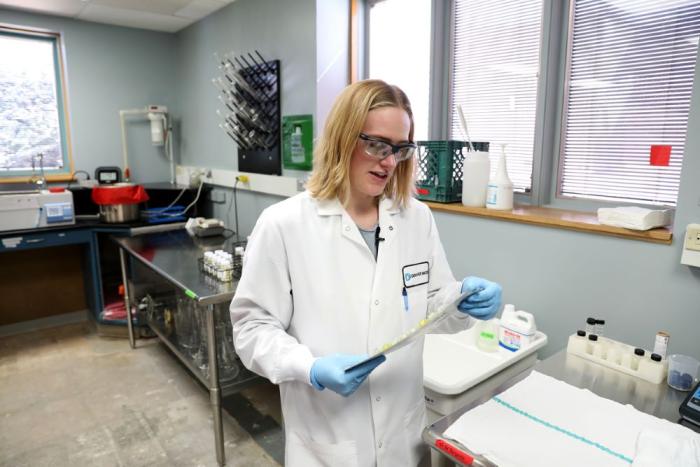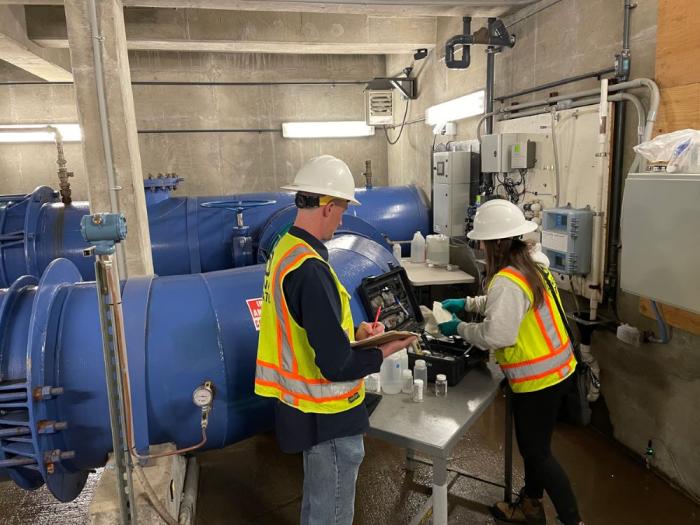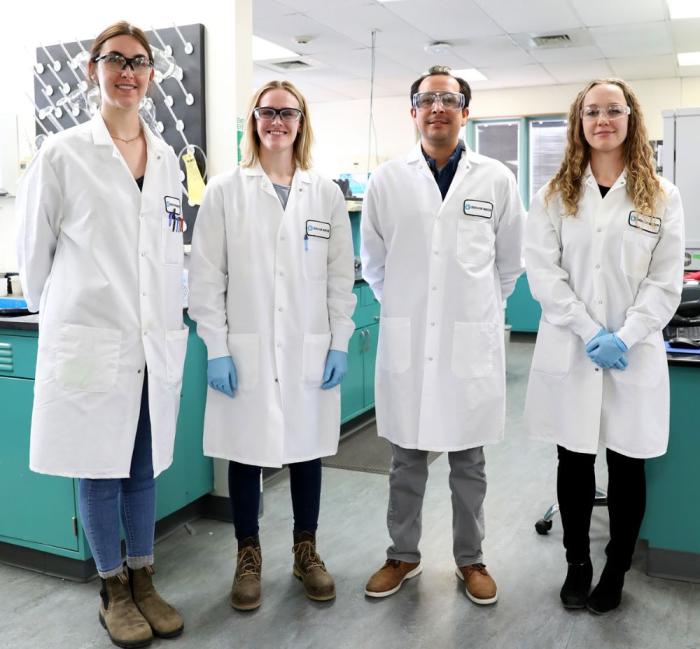Testing the waters
By Coleman Cornelius
Editor’s note: This TAP article, done in partnership with the Colorado State University System, originally ran in the Winter 2023 edition of STATE, the magazine of the CSU System.
When we think of household water, we might envision a kitchen faucet. Maybe a shower. A toilet. Or lawn irrigation. Not so much a bunny slope at Winter Park Resort.
But that’s where Ashley Luscan and Christian Ramos were in February 2022. The two employees of Denver Water had rumbled up a Winter Park beginner’s run in a utility terrain vehicle, equipped with tracks like those of a snowcat to navigate the terrain. They sought 4 liters of water to test it for purity.
Luscan and Ramos would draw the sample from Vasquez Creek, as the stream flowed from the headwaters of the Colorado River along the mountainous Continental Divide, at 13,000 feet. Some of this water, mainly snowmelt, is diverted from the watershed through a complex system featuring a giant tunnel, stream, canals, reservoirs, a water treatment plant, and pipelines, then finally to homes and businesses in Denver and surrounding suburbs, some 70 miles away.
Monitoring the vital resource from forest to faucet can be an undertaking. On this February day, an impassable snowbank blocked the preferred route to the Vasquez Creek sampling spot. So, Luscan and Ramos opted for Plan B, starting from the base of Winter Park Resort and soon winding into Vasquez Peak Wilderness.
“This is not typical,” Luscan said, peering through the UTV windshield at skiers and snowboarders. Some quizzically watched the vehicle, as a dad instructed his snowplowing kid and a teenaged snowboarder whizzed by.
Despite their detour, Luscan and Ramos were remarkably dedicated to checking the source of Denver’s water. “The work is incredibly important,” Ramos said, after arriving at the remote destination, surrounded by a sparkling, snow-covered landscape.
“We’re safeguarding Denver’s water supply. If someone isn’t doing this, we can’t provide confidence for our users. It’s very rewarding for me.”
Ramos, who has college degrees in environmental science and hydrology, was motivated to work in water quality after growing up in Burlington, on Colorado’s Eastern Plains. As a boy, he and his family could not drink their tap water because of high nitrate levels. Instead, they relied on bottled water for drinking and cooking.
Now, he and Luscan are part of a Denver Water team that regularly draws water samples from 298 sites, ranging from mountains to municipal taps. The team collects and runs initial analyses on samples from a vast network of mountain streams, reservoirs, three water treatment plants, the metro distribution system, and discharge locations.
The collection sites are established for reporting water-quality data in compliance with Colorado Department of Public Health and Environment and Environmental Protection Agency regulations, as well as Denver Water’s own standards.
Read more stories about the water quality team at Denver Water.
All water utilities are required by state and federal laws to regularly sample and test water delivered to users. The Denver program is notable for its scope: Denver Water is Colorado’s oldest and largest water utility, funded with water rates, hydropower revenues and new tap fees. The utility delivers water to 1.5 million people in metro Denver; that’s one-fourth of the state population of 5.8 million.
To quench that thirst, Denver Water’s collection area covers 4,000 square miles in the foothills and mountains west of Denver. That’s almost the size of Connecticut. The utility collects about half its water from the Upper Colorado River Basin and half from the Upper South Platte River Basin.
Colorado is well known as a headwaters state: The state’s rivers originate here — formed by snowmelt and rain high in the Rocky Mountains — and flow out to other states and Mexico, where they likewise are relied upon as vital water sources.
This status as first user adds weight to the responsibility of monitoring water quality because Denver Water logs data that may be referenced by many other agencies and downstream utilities.
Yet, field work is only one part of monitoring the supply that Denver Water delivers. A portion of every sample is ferried to the utility’s water quality laboratory, adjacent to the Marston Water Treatment Plant in southwest Denver.
Last year, the lab received 55,000 water samples and conducted more than 200,000 tests. These tests analyze characteristics including basic water chemistry and levels of metals, suspended particles, taste and odor compounds, and bacteria of interest.
Results help the utility understand normal parameters for water in the system, spot trends in source water characteristics, and, importantly, establish handling and disinfection protocols at Denver Water treatment plants that funnel water into the municipal distribution system.
In late 2022, the utility’s water quality laboratory began moving to the third floor of the new Hydro building at CSU Spur, where it will occupy 19,000 square feet of space.
That will make Denver Water the primary tenant in a building devoted to water-related research and public education. Here, the lab will conduct water quality analyses with leading-edge instruments and other equipment valued at about $1.5 million, most moved from the lab’s aging building in southwest Denver.
The move will expand the water quality lab’s testing capacity and will put it shoulder to shoulder with university and other researchers.
“This is an exciting development for the lab and for Denver Water as a whole,” said Nicole Poncelet-Johnson, the utility’s director of water quality and treatment. “It puts us right in the heart of a new research environment, in a spot where we can work far more closely and readily with academics and other innovators studying a wide spectrum of current and emerging water quality issues.”
The Hydro building is one of three at the CSU Spur campus, which is being developed by the Colorado State University System with a $250 million allocation from the Colorado General Assembly.
CSU Spur is the educational anchor at the National Western Center in north Denver. But it won’t grant college degrees. Instead, the campus is unique in its dedication to public education, research and community outreach, with a particular focus on attracting K-12 students to college and careers in food, water, and animal and human health.
These are critical fields, threading through some of the globe’s knottiest problems, and are areas of expertise for the CSU System and its degree-granting campuses.
After the Hydro building opened in January 2023, some of the work of the water quality lab is on full view for visitors. In addition, Denver Water’s youth education team has begun leading regular hands-on activities for kids.
“I’m really excited for our public engagement and potentially being an inspiration to future scientists,” Alfonso Gonzales, manager of the water quality lab, said.
Gonzales recalled his own inspiration, the moment he decided to study biology and chemistry. While taking a college biology class, he examined algae under a microscope and was fascinated by the tiny aquatic organisms. His professor’s enthusiasm for algae bloomed in Gonzales, and soon he was on a career path in science.
Algae, it turns out, are key indicators of ecosystem health and water quality. Gonzales didn’t know it in college, but he would later run a laboratory that examines water for algae that could compromise the quality of Denver’s tap water.
Of particular interest: several kinds of blue-green algae and bacteria that produce compounds called geosmin and 2-methylisoborneol.
Mention these compounds to a water-quality expert, and their heart will likely sink — if they aren’t too busy responding to complaints. That’s because geosmin and 2-methylisoborneol taint drinking water with an earthy, musty taste and odor. The compounds are not harmful, but are sure to provoke customer grievance, even at levels as infinitesimal as 5 parts per trillion. (Humans are bizarrely attuned.)
When Gonzales’ lab confirms these compounds and their concentration, Denver Water uses the information to adjust system flows in order to bypass the problematic source. The utility further treats water with activated carbon filtration, in addition to its standard filtration and disinfection processes. Such events occur a couple times a year.
“Our objective is to create high-quality data so we can accurately monitor what’s occurring in our watersheds, reservoirs, treatment plants and distribution system, which ends at the customer’s tap,” Gonzales said. “The ultimate goal is to provide safe, clean drinking water for our customers. Our laboratory is contributing to the protection of public health. Being a customer myself, I’m glad we do what we do.”
Testing starts with raw water high in the watersheds, including the Vasquez Creek site near Winter Park, where Luscan and Ramos arrived after their detour.
The two strapped on snowshoes and hiked to the stream. Ramos used an extension pole to reach a liter bottle over the snow, dipping it into the cold, gurgling creek. After collecting the sample, the two trekked back to the UTV, where they had a miniature lab set up on the tailgate.
They gauged the water’s temperature, conductivity, pH, dissolved oxygen and turbidity, recording each reading on a laptop. These data would supplement and provide a comparative basis for additional tests back at the water quality lab.
Turbidity is among the most straightforward of water’s characteristics — a measure of cloudiness from suspended particles.
“It tells us a lot about our source water,” Ramos said, holding up a vial of clear water. A meter assessed the sample at 0.21 Nephelometric Turbidity Units. “That’s very clear,” Ramos pronounced.
Meet Katie Ross, an engineering manager at Denver Water who worked on the redevelopment plans at the National Western Center.
Not all mountain water is so pure. In 2002, the infamous Hayman Fire scorched about 138,000 acres in the southeast section of Denver Water’s collection area, in the South Platte River Basin.
Its aftermath produced years of challenges for Denver Water. For instance, the utility adopted intensive filtration processes to catch sooty sediment carried into source water through runoff — the problem reflected in turbidity measurements.
The utility’s water quality lab also kept close tabs on manganese. The trace mineral is healthy in small amounts but often degrades source water after wildfires. So, cued by tests at the water quality lab, Denver Water used oxidation and other treatment processes to ensure safe levels.
Such analysis illustrates the lab’s role in tracking water quality during emergencies. That role will likely grow as climate change further impacts watersheds, said James Berrier, water quality monitoring supervisor.
“Climate change is our biggest challenge and our biggest risk,” Berrier said. “It’s a major concern for all water providers in our region. Wildfires, water loss, uncertain water resources, severe drought, severe storms — climate change shakes everything up.”
Back at the lab, a Denver Water team conducted further analyses on the raw water transported from Vasquez Creek. For example, a process called inductively coupled plasma mass spectrometry identified minute concentrations of metals and minerals that enter source water through the natural environment.
Those measured include manganese, which was problematic after the Hayman fire, and 26 other substances that might be found in snowmelt, including aluminum, barium, calcium, magnesium, potassium and sodium.
The sample checked out as “about as pure as water gets,” Berrier said. “The sampling location is so close to the upper end of the watershed that the water has not had a chance to pick up minerals and other compounds that are naturally incorporated when water moves through soil and rock.”
On a different winter day, another field crew parked on a residential street in central Denver, walked through a locked iron gate, opened a sealed hatch door, and clambered into an underground vault.
A 48-inch steel pipe, painted bright blue, ran horizontally through the concrete vault carrying treated water to Denver customers. It is part of a distribution system with 3,000 miles of pipeline. In this case, the pipe carried water that originated in the Upper South Platte River Basin and had been channeled through Marston Reservoir and the Marston Water Treatment Plant. Now it was ready for drinking.
But first, Molly McConnell and Hayden Simons were there to conduct a field test and to carry a sample back to the water quality laboratory.
McConnell and Simons ran the same assessments the team had run on raw water at Vasquez Creek — with the addition of a chlorine measurement, as this water already had been through filtration and disinfecting processes at the treatment plant.
In fact, the water in this underground pipe was analyzed three times over: with instruments that ran continuously in the vault, with field tests, and with sophisticated assessments in the lab.
“It’s all part of our quality control,” said Simons, who graduated from Colorado State University in 2019 with a degree in biological science.
Their next stop was a home in northwest Denver, representing the terminus for water in the distribution system. Here, McConnell and Simons collected a sample that would be scrutinized at the water quality lab for possible lead content.
The home is in Denver Water’s Lead Reduction Program; that means, based on its age, the house could have a lead service line carrying water into the house from the main line in the street.
Tap water from homes in the program is routinely checked for the metal that can leach from lead service lines and plumbing, becoming dangerous to human health if it reaches high levels. Those in the program also receive filters to eliminate the potential for unsafe tap water.
Denver Water manages and monitors its distribution system to make sure water it provides is lead free. However, homeowners own their service lines and plumbing; that’s where problematic lead levels may arise. At homes in the Lead Reduction Program, Denver Water is in the process of replacing lead service lines with lines made from safer materials in an effort to fully purge lead from the system.
“We want to make sure everything we’ve done at the treatment plant is represented at this faucet,” McConnell said, as she stood in the homeowner’s kitchen. She collected water straight from the faucet and from a pitcher with filtration that is effective in removing lead. The samples tested within normal parameters at the water quality laboratory.
Water distribution and testing have come a long way since Denver’s early days when people filled buckets from the South Platte River. Contemporary work in water quality is essential, Luscan said, as she stood in the snowy setting at Vasquez Creek screening samples.
“To ensure that people are getting safe, clean water, it’s important to have people who are passionate about water quality in this field,” she said. “I believe clean drinking water is a basic human right, and I enjoy being part of that on a small scale.”
You can read more stories about happenings at Colorado State University on STATE.


